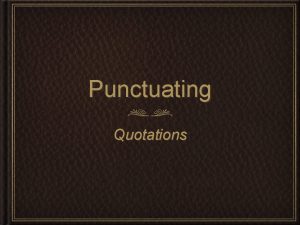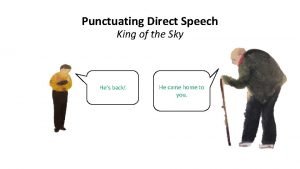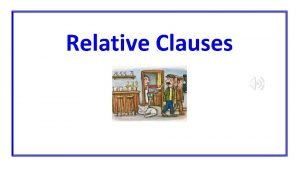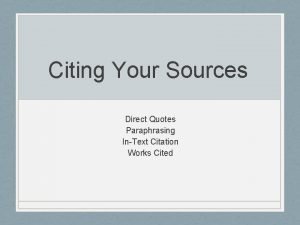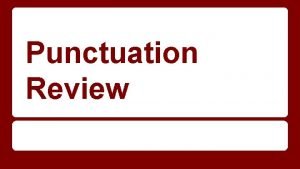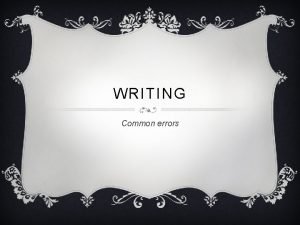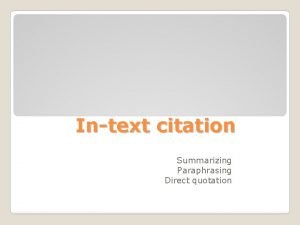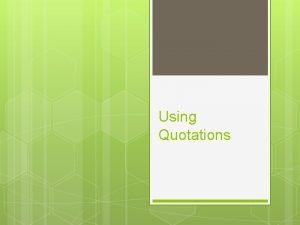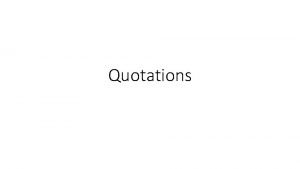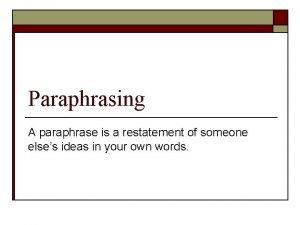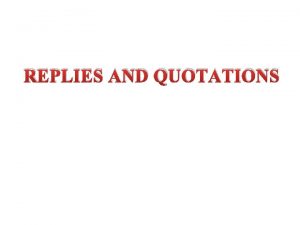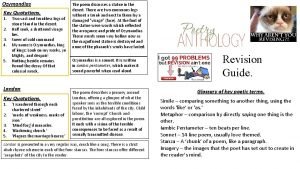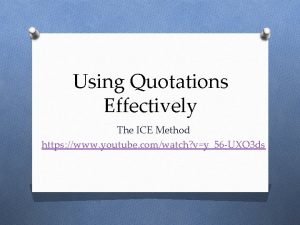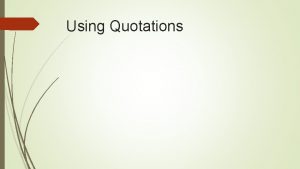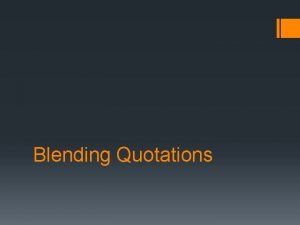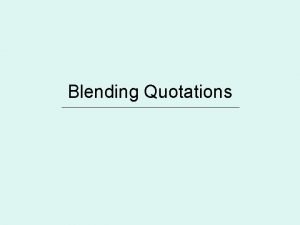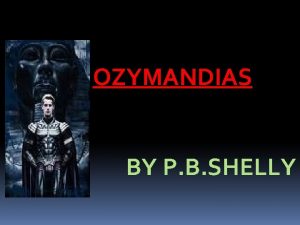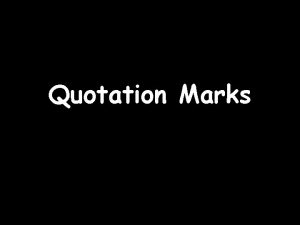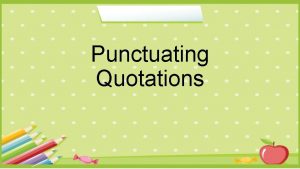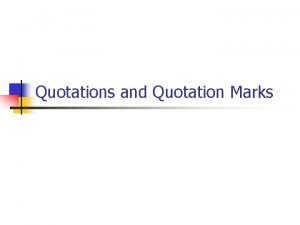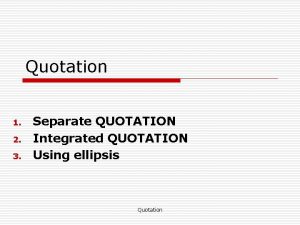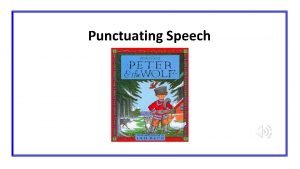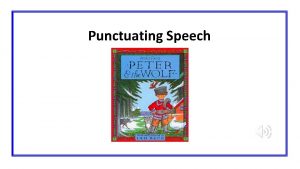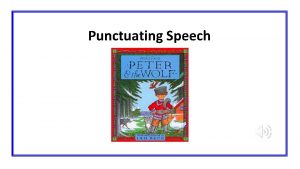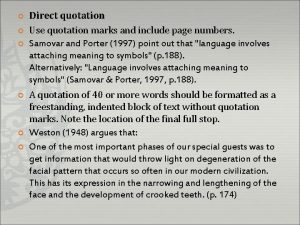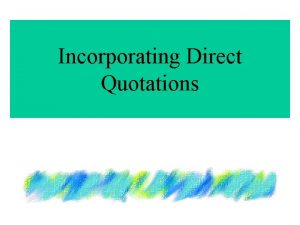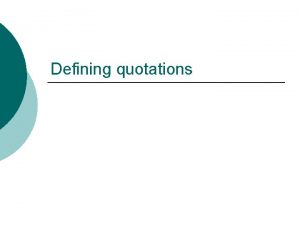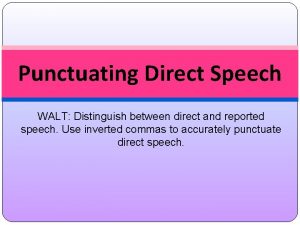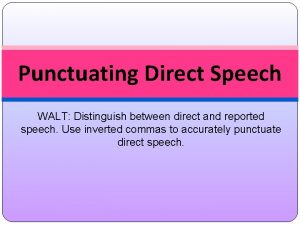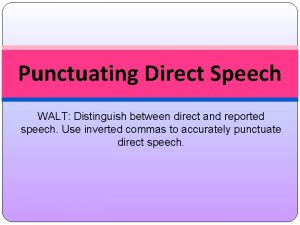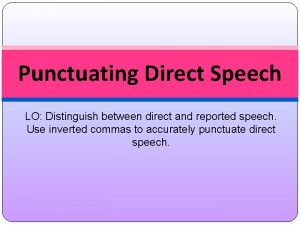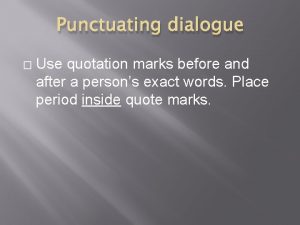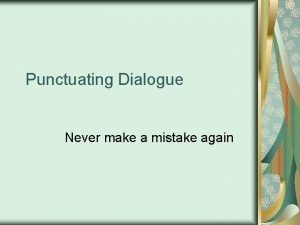Punctuating Quotations What is a direct quotation A
































- Slides: 32

Punctuating Quotations

What is a direct quotation?

A speaker’s exact words (also called dialogue).

That’s when Jane said, “You must have a tea party!”

What is an indirect quotation?

A restatement of what someone said, often introduced by the word that.

Jane said she thought Carla should have a tea party.

A direct quotation is a report of a speaker’s exact words Rule #1 Use quotation marks at the beginning and end of a direct quotation. “I would love to come to tea, ” she answered.

A direct quotation is a report of a speaker’s exact words Rule #2 Use commas to set off explanatory words ued with direct quotations (whether they occur at the beginning in the middle, or at the end of the sentence).

A direct quotation is a report of a speaker’s exact words For Example Mark said, “I didn’t get an invitation. ” “I also, ” said Jean, “didn’t get an invitation. ” “I wonder why that is? ” Mark said.

A direct quotation is a report of a speaker’s exact words Rule #3 If a quotation is a question or an exclamation, place the question mark or exclamation point inside the closing quotation marks.

A direct quotation is a report of a speaker’s exact words Rule #3 “Who wants to ask her if there was a mistake? ” asked Carla.

A direct quotation is a report of a speaker’s exact words Rule #4 If quoted words are part of a question or exclamation, place the question mark or exclamation point outside the closing quotation mark.

A direct quotation is a report of a speaker’s exact words Rule #4 Did Carla just say, “I hate drinking tea”? The entire phrase is a question.

Note Commas and periods always go inside closing quotation marks. They’re too little to stay outside. . .

An indirect quotation mark is a restatement of someone’s words. Rule #5 Do not use quotation marks to set off an indirect quotation. He told me that he couldn’t be there.

Divided Quotation Rule #6 Use quotation marks to enclose both parts of a divided quotation. “Carla, ” Jane called, “I have your invitation here. ”

Divided Quotation Rule #7 Do not capitalize the first word of the second part of a divided quotation unless it begins a new sentence. Capitalize: “If you want to come, ” Jane said, “let me know. ” Do Not Capitalize: “I’ll check my calendar, “ Carla said. “I will call you later. ”

Divided Quotation Rule #8 Use commas to set off the explanatory words used with a divided quotation. “Wow, ” Mark said, “she didn’t invite me, and I was standing right next to you. ”

Dialogue Rule #9 In dialogue, a new paragraph and a new set of quotation marks signal a change in speakers.

Try These Examples

Where should we place the quotation marks? John said, That’s my coat.

Where should we place the quotation marks? John said, “That’s my coat. ”

Where should we place the quotation marks? Help! shouted the scoutmaster. We can’t find our way out of this cave!

Where should we place the quotation marks? “Help!” shouted the scoutmaster. “We can’t find our way out of this cave!”

Where should we place the quotation marks? He said that he wasn’t going with us.

Where should we place the quotation marks? He said that he wasn’t going with us. No comma needed.

Where should we place the quotation marks? This beach, said Dad, is more beautiful than ever.

Where should we place the quotation marks? “This beach, ” said Dad, “is more beautiful than ever. ”

Where should we place the quotation marks? William exclaimed, I can’t believe we’re finally here!

Where should we place the quotation marks? William exclaimed, “I can’t believe we’re finally here!”

Complete Practice and Apply 2, page 260 and Exercise 4, page 637 (Yes, you have to write out the sentences. )
 Punctuating direct quotations
Punctuating direct quotations Punctuating direct speech
Punctuating direct speech What is a main clause
What is a main clause In text citation
In text citation Indirect and direct quotations
Indirect and direct quotations Paraphrase citation apa
Paraphrase citation apa Punctuating compound sentences
Punctuating compound sentences Give at least three time keeping or punctuating instruments
Give at least three time keeping or punctuating instruments Punctuating titles
Punctuating titles Punctuating dialogue rules
Punctuating dialogue rules Punctuating book titles
Punctuating book titles Split speech example
Split speech example Direct quotation
Direct quotation Direct quotation examples
Direct quotation examples Direct quotation lead
Direct quotation lead What is a partial quotation
What is a partial quotation Integrated direct quotation
Integrated direct quotation When do you use italics
When do you use italics Restatement and paraphrasing
Restatement and paraphrasing Enquiry email sample for a quotation
Enquiry email sample for a quotation Ozymandias poem explanation with quotations
Ozymandias poem explanation with quotations Ice method english
Ice method english Macbeth act 3 scene 1 key quotes and analysis
Macbeth act 3 scene 1 key quotes and analysis Whats a signal phrase
Whats a signal phrase Quote citation
Quote citation Daffodils quotations
Daffodils quotations Nested quotations
Nested quotations Framing quotations example
Framing quotations example Integrating quotations exercise
Integrating quotations exercise Embedding quotations 7
Embedding quotations 7 Templates for introducing quotations
Templates for introducing quotations Quotes about blending in
Quotes about blending in P.b.shelly
P.b.shelly
